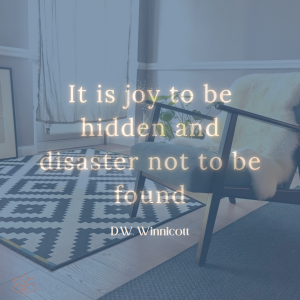
Winnicott wrote this quote in his paper “Communicating and Not Communicating Leading to a Study of Certain Opposites” (1963), a wonderful paper that addresses a central dilemma inherent in all of us. He goes on to say, “each individual is an isolate, permanently non-communicating, permanently unknown, in fact unfound.”
I think we can all relate to this, and no where else is it more felt than in the ambivalence of the consulting room. Nothing feels more real and true than the self that we do not explicitly want to communicate. There we exist in sacred isolation, feeling the need to preserve this inner sanctum at all costs. Yet the disaster in being unfound lies in the essential loneliness of this fact. We come to therapy to be known or found in some way so that our suffering can become more understandable, more bearable whilst at the same time acknowledging that there will always be an unfound self that cannot be communicated.
Winnicott’s question “How to be isolated without having to be insulated?” becomes then a comfort that acknowledges the paradox while instilling hope that the parts of self in need of being found can eventually be communicated and known.
